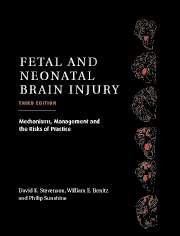Book contents
- Frontmatter
- Contents
- List of contributors
- Foreword
- Preface
- Part I Epidemiology, Pathophysiology, and Pathogenesis of Fetal and Neonatal Brain Injury
- Part II Pregnancy, Labor, and Delivery Complications Causing Brain Injury
- Part III Diagnosis of the Infant with Asphyxia
- Part IV Specific Conditions Associated with Fetal and Neonatal Brain Injury
- 26 Hypoglycemia in the neonate
- 27 Hyperbilirubinemia and kernicterus
- 28 Polycythemia
- 29 Hydrops fetalis
- 30 Acidosis/alkalosis
- 31 Meconium staining and the meconium aspiration syndrome
- 32 Persistent pulmonary hypertension of the newborn
- 33 Pediatric cardiac surgery: relevance to fetal and neonatal brain injury
- Part V Management of the Depressed or Neurologically Dysfunctional Neonate
- Part VI Assessing the Outcome of the Asphyxiated Infant
- Index
- Plate section
26 - Hypoglycemia in the neonate
from Part IV - Specific Conditions Associated with Fetal and Neonatal Brain Injury
Published online by Cambridge University Press: 10 November 2010
- Frontmatter
- Contents
- List of contributors
- Foreword
- Preface
- Part I Epidemiology, Pathophysiology, and Pathogenesis of Fetal and Neonatal Brain Injury
- Part II Pregnancy, Labor, and Delivery Complications Causing Brain Injury
- Part III Diagnosis of the Infant with Asphyxia
- Part IV Specific Conditions Associated with Fetal and Neonatal Brain Injury
- 26 Hypoglycemia in the neonate
- 27 Hyperbilirubinemia and kernicterus
- 28 Polycythemia
- 29 Hydrops fetalis
- 30 Acidosis/alkalosis
- 31 Meconium staining and the meconium aspiration syndrome
- 32 Persistent pulmonary hypertension of the newborn
- 33 Pediatric cardiac surgery: relevance to fetal and neonatal brain injury
- Part V Management of the Depressed or Neurologically Dysfunctional Neonate
- Part VI Assessing the Outcome of the Asphyxiated Infant
- Index
- Plate section
Summary
Blood sugar measurements in neonates date back to the beginning of the twentieth century. By the 1920s it was known that concentrations of glucose were lower in premature (<2500 g birth weight) than in term infants, and both were less than those in older infants. In 1937, Hartmann and Jaudon first described a series of 286 neonates and infants with severe, recurrent, and/or persistent manifestations of hypoglycemia based on “true” blood sugar values. Their definitions distinguished between degrees of hypoglycemia based on the concept that all deviations from biological norms represent a continuum of abnormality. Thus, “mild” hypoglycemia was arbitrarily defined between 40 and 50 mg/dl (2.2–2.8 mmol/l); “moderate” between 20 and 40 mg/dl (1.1–2.2 mmol/l); and “extreme” less than 20 mg/dl (<1.1 mmol/l). These “true” blood sugar values were marginally greater than the blood glucose values measured today.
These classical reports stimulated little interest. Furthermore, no clinical significance was attributed to these variations in blood sugar values, even if extremely low (<20 mg/dl: 1.1 mmol/l). In fact, only isolated cases of hypoglycemic neonates, usually from postmortem examination, appeared until 1954, when McQuarrie reported his experience with familial recurrent severe hypoglycemia. In 1959, the report of transient symptomatic neonatal hypoglycemia in eight infants changed the concept and attitude to neonatal hypoglycemia. Significant clinical manifestations occurred with laboratory blood or spinal fluid glucose values <20–25 mg/dl, and cleared after restoring the blood glucose concentration to normal (>40 mg/dl).
- Type
- Chapter
- Information
- Fetal and Neonatal Brain InjuryMechanisms, Management and the Risks of Practice, pp. 553 - 570Publisher: Cambridge University PressPrint publication year: 2003
- 1
- Cited by



